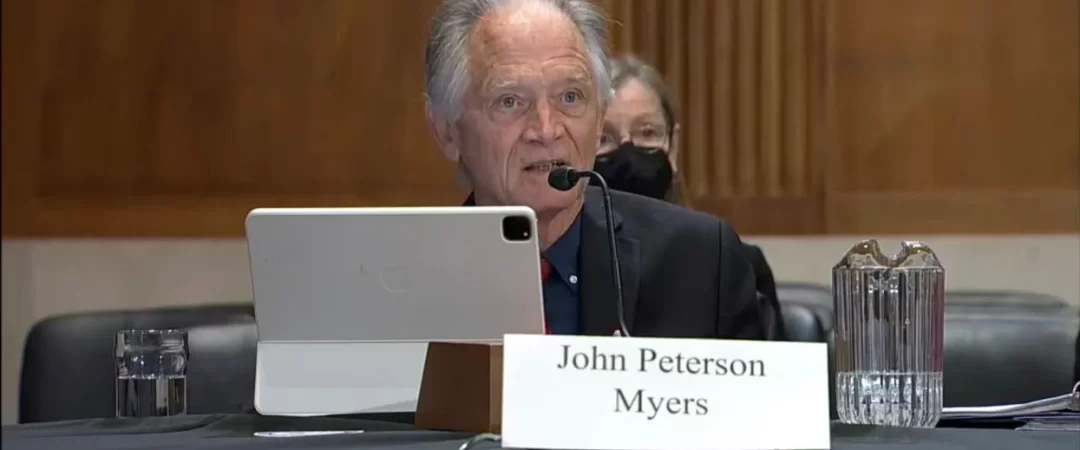
See the EDC policy updates page for news on regulations and policy as they happen.
This section highlights major agencies that are responsible for regulations and policies related to endocrine disrupting chemicals (EDCs), and new policy issues relating to EDCs, including issues that require immediate attention. The top section covers U.S.-focused organizations, followed by Europe, then International policy resources.
United States
For a handy cheat-sheet of which chemicals are regulated by which U.S. organizations, see The Big Chart of Federal Chemical Evaluations & Assessments by Rachel Shaffer and accompanying blog.
Environmental Protection Agency (EPA)
The EPA regulates environmental chemicals and develops testing strategies for EDCs via the Endocrine Disruptor Screening Program (EDSP). The EDSP is mandated to use validated methods for the screening and testing chemicals to identify potential endocrine disruptors, determine adverse effects, dose-response, assess risk and ultimately manage risk under current laws. These methods or assays allow EPA to identify and characterize the endocrine activity (specifically, estrogen, androgen and thyroid) of pesticides, commercial chemicals, and environmental contaminants. The EPA’s endocrine disruption site has information on endocrine disruptors and endocrine disruption, along with information on regulatory resources, and the progress of the chemical screening and testing process. The CompTox Chemical Dashboard is an online resource for toxicology information on 875,000 chemicals, including EDCs.
U.S. Food and Drug Administration (FDA)
Hosts the Endocrine Disruptor Knowledge Base database. The FDA is better known for not regulating EDCs than for regulating them. It considers BPA to be “safe.”
U.S. National Institute of Environmental Health Sciences (NIEHS)
NIEHS is a major funder of EDC research. It is also a good source of information on EDCs and funding opportunities. See the NIEHS Strategic Plan. NIEHS funds numerous centers and programs that work on EDC-related issues, including:
- the Breast Cancer and the Environment Research Program,
- the Centers of Excellence on Environmental Health Disparities Research,
- the Children’s Environmental Health and Disease Prevention Research Centers,
- the Environmental Health Sciences Core Centers, and
- the Superfund Research Program.
NIEHS also hosts the Interagency Coordinating Committee on the Validation of Alternative Methods (ICCVAM), which is composed of representatives from 17 U.S. federal regulatory and research agencies. These regulatory and research agencies require, use, generate, or disseminate toxicological and safety testing information.
Program on Reproductive Health and the Environment (PRHE)
Located at the University of California at San Francisco (UCSF), PRHE’s mission is to create a healthier environment for human reproduction and development through advancing scientific inquiry, clinical care and health policies that prevent exposures to harmful chemicals in our environment. PRHE works at the intersection of science, medicine, policy and community. They conduct targeted research, translate scientific findings in order to expand clinical practice, and advance science-based policy solutions.
- More about PRHE Research
- More about PRHE efforts to translate the science into improved Public Policy
PRHE applies respected scientific expertise to answer complex environmental health-related questions and to develop science-based policy strategies. PRHE activities include:
- Creating a science-based foundation for policy by evaluating, synthesizing, translating and interpreting scientific findings for relevant audiences, including policy makers, the public, patients and health affected and community groups.
- Creating policy options and tools to interpret scientific findings for use in policy and decision making and in optimizing prevention and interventions.
- Delivering critical scientific information to decision makers by establishing a broad base of scientists, community groups and health care providers and connecting this community to decision makers at the state and federal level.
U.S. State Regulations
Safer States
A network of environmental health coalitions and organizations in states around the U.S. that tracks state-level chemical policies and bills.
For other organizations who work on EDCs, see the Organizations page.
Europe
Chemicals Strategy
In October 2020, the European Commission passed a new strategy on chemicals. For information and reactions, see:
- Green Deal: Commission adopts new Chemicals Strategy towards a toxic-free environment (press release from the EU)
- Endocrine Society welcomes European Commission’s chemical strategy (press release from the Endocrine Society)
- EU chemicals strategy: speedy implementation steps key to truly protect people’s health (blog from Europe’s Health and Environment Alliance (HEAL))
EDC Resolution
The EU Parliament adopted a resolution on a framework for EDCs in April, 2019.
The Council of the European Union adopted conclusions on chemicals which offer political guidance on the development of a sustainable EU chemicals policy strategy in June 2019. See the Press Release and the full text.
REACH stands for Registration, Evaluation, Authorisation and Restriction of Chemicals. It entered into force on June 1, 2007. The European Chemicals Agency (ECHA) implements REACH, the EU’s groundbreaking legislation on chemicals.
REACH is a regulation of the European Union, adopted to improve the protection of human health and the environment from the risks that can be posed by chemicals, while enhancing the competitiveness of the EU chemicals industry. It also promotes alternative methods for the hazard assessment of substances in order to reduce the number of tests on animals.
In principle, REACH applies to all chemical substances; not only those used in industrial processes but also in our day-to-day lives, for example in cleaning products, paints as well as in articles such as clothes, furniture and electrical appliances. Therefore, the regulation has an impact on most companies across the EU.
REACH places the burden of proof on companies. To comply with the regulation, companies must identify and manage the risks linked to the substances they manufacture and market in the EU. They have to demonstrate to ECHA how the substance can be safely used, and they must communicate the risk management measures to the users.
If the risks cannot be managed, authorities can restrict the use of substances in different ways. In the long run, the most hazardous substances should be substituted with less dangerous ones.
EU Commission Resources:
EU Eurion Cluster Horizon 2020 Projects on EDCs
The EU is funding a number of research projects on endocrine disrupting chemicals as part of Horizon 2020, including the Eurion Cluster (@EurionCluster), European Cluster to Improve Identification of Endocrine Disruptors. The cluster includes eight projects on new testing and screening methods to identify EDCs: ATHENA, EDCMET, ENDpoiNTs, ERGO, FREIA, GOLIATH, OBERON, and SCREENED. These projects are described in a series of articles published in the International Journal of Molecular Sciences; see links below.
ATHENA: Assays for the identification of Thyroid Hormone axis – disrupting chemicals: Elaborating Novel Assessment strategies
Website: ATHENA Project
Twitter: @ATHENAprojectEU
See: Removing Critical Gaps in Chemical Test Methods by Developing New Assays for the Identification of Thyroid Hormone System-Disrupting Chemicals—The ATHENA Project. Kortenkamp et al. Int. J. Mol. Sci. 2020, 21, 3123.
EDCMET: Metabolic effects of Endocrine Disrupting Chemicals: novel testing METhods and adverse outcome pathways
Website: EDCMET Project
Twitter: @edcmet_eu
See: The EDCMET Project: Metabolic Effects of Endocrine Disruptors. Küblbeck et al. Int. J. Mol. Sci. 2020, 21, 3021.
ENDpoiNTs: Novel Testing Strategies for Endocrine Disruptors in the Context of Developmental NeuroToxicity
Website: ENDpoiNTs Project
See: The ENDpoiNTs Project: Novel Testing Strategies for Endocrine Disruptors Linked to Developmental Neurotoxicity. Lupu et al. Int. J. Mol. Sci. 2020, 21, 3978.
ERGO: Breaking down the wall between human health and environmental testing of endocrine disrupters: EndocRine Guideline Optimisation
Website: ERGO Project
Twitter: @ERGO_EU
See: ERGO: Breaking Down the Wall between Human Health and Environmental Testing of Endocrine Disrupters. Holbech et al. Int. J. Mol. Sci. 2020, 21, 2954.
FREIA: Female Reproductive toxicity of EDCs: a human evidence-based screening and Identification Approach
Website: FREIA Project
Twitter: @freiaprojectEU
See: Safeguarding Female Reproductive Health Against Endocrine Disrupting Chemicals—The FREIA Project. van Duursen et al. Int. J. Mol. Sci. 2020, 21, 3215.
GOLIATH: Generation Of NoveL, Integrated and Internationally Harmonised Approaches for Testing Metabolism Disrupting Compounds
Website: GOLIATH Project
Twitter: @beating_goliath
See: The GOLIATH Project: Towards an Internationally Harmonised Approach for Testing Metabolism Disrupting Compounds. Legler et al. Int. J. Mol. Sci. 2020, 21, 3480.
OBERON: An integrative strategy of testing systems for identification of Endocrine Disrupters related to metabolic disorders
Website: OBERON Project
Twitter: @OBERON_4EU
See: Integrative Strategy of Testing Systems for Identification of Endocrine Disruptors Inducing Metabolic Disorders—An Introduction to the OBERON Project. Aodouze et al. Int. J. Mol. Sci. 2020, 21, 2988.
SCREENED: Screening for endocrine disruptors; Development of three-dimensional (3D) cell-based in vitro tests to better characterize the effects of endocrine disruptors on thyroid functions
Website: SCREENED Project
Twitter: @ScreenedH
See: SCREENED: A Multistage Model of Thyroid Gland Function for Screening Endocrine-Disrupting Chemicals in a Biologically Sex-Specific Manner. Moroni et al. Int. J. Mol. Sci. 2020, 21, 3648.
Additional EU projects:
The European Human Biomonitoring Initiative
A joint initiative to coordinate and advance human biomonitoring in Europe. HBM4EU is generating evidence of the actual exposure of citizens to chemicals and the possible health effects in order to support policy making.
Website: European Human Biomonitoring Initiative
Twitter: @HBM4EU
EU-ToxRisk: An Integrated European ‘Flagship’ Programme Driving Mechanism-based Toxicity Testing and Risk Assessment for the 21st century
Website: EU-ToxRisk
Twitter: @EU_ToxRisk
PROTECTED: Protection Against Endocrine Disruptors
Website: PROTECTED
Twitter: @PROTECTED_ITN
EU List of Endocrine Disruptors
This website, Endocrine Disruptor Lists, makes public the current status of substances identified as endocrine disruptors, or under evaluation for endocrine disrupting properties within the EU.
Danish Centre on Endocrine Disrupters (CeHoS)
CeHoS’s mission is to build and gather new scientific knowledge on endocrine disruptors with the focus on providing information requested for the preventive work of the regulatory authorities. See their Report on Interpretation of knowledge on endocrine disrupting substances (EDs) – what is the risk? (2019)
EDC-MixRisk
This EU project focused on the effects of mixtures of endocrine disruptive chemicals on children. See their final policy brief (2019).
EuroMix
The EuroMix project aims to deliver a mixture test strategy and test instruments using novel techniques, resulting in data needed for refining future risk assessment of mixtures relevant to national food safety authorities, public health institutes, the European Food Safety Authority (EFSA), the European Chemical Agency (ECHA), industry, regulatory bodies and other stakeholders.
European Food Safety Authority (EFSA)
EFSA is a European agency funded by the European Union that operates independently of the European legislative and executive institutions (Commission, Council, Parliament) and EU Member States.
It was set up in 2002 following a series of food crises in the late 1990s to be a source of scientific advice and communication on risks associated with the food chain. The agency was legally established by the EU under the General Food Law – Regulation 178/2002.
The General Food Law created a European food safety system in which responsibility for risk assessment (science) and for risk management (policy) are kept separate. EFSA is responsible for the former area, and also has a duty to communicate its scientific findings to the public.
See EFSA’s overview of endocrine active substances.
International
United Nations
The United Nations Environment Program (UN Environment) is the leading global environmental authority that sets the global environmental agenda, promotes the coherent implementation of the environmental dimension of sustainable development within the United Nations system, and serves as an authoritative advocate for the global environment.
The International Panel on Chemical Pollution (IPCP) released overview reports on EDCs that it had prepared for the United Nations Environment Programme (UN Environment) in 2018. These include reports on:
- Existing initiatives to identify EDCs,
- Current scientific knowledge on life cycles, environmental exposures, and environmental effects of EDCs, and
- Existing regulatory frameworks for EDCs.
Organization for Economic Co-operation and Development (OECD)
World Health Organization (WHO)
The International Cooperation on Alternative Test Methods, ICATM
ICATM is an international cooperation that includes governmental organizations from around the world to promote enhanced international cooperation and coordination on the scientific development, validation and regulatory use of alternative approaches.
Comments
HEEDS has just begun to submit comments to regulatory agencies on topics related to endocrine disruption. Here are some of the comments we have submitted.
Comment from Healthy Environment and Endocrine Disruptor Strategies (HEEDS), Posted by the Food and Drug Administration on Mar 31, 2021, on a Citizen Petition from Environmental Defense Fund.
